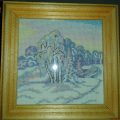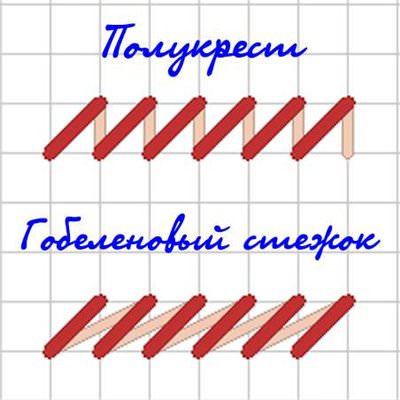
How to make a monochrome cross-stitch embroidery, monochrome cross-stitch for beginners with a photo and description.
It is generally accepted that monochrome embroidery isthe best option for beginners. This is explained by the fact that only 2 thread colors are used in this kind of embroidery. Therefore, beginners in the art of needlework are advised to use the scheme for black and white embroidery. In this article, we will talk about the varieties of monochrome embroidery, as well as how to create a canvas, embroidered monochrome, correctly and quickly. On the eve of the Christmas holidays, embroidery is becoming especially relevant. After all, embroidered or created with the help of embroidery products can be an excellent souvenir for the New Year or Christmas. Creation of the technique of embroidery monochrome paintings is in great demand among beginners and skilled needlewomen. This kind of embroidery will not take you much time. A picture of this type will be an original addition to any interior. Experts argue that monochrome embroidery owes its existence to the ancient Egyptians, and among noble English and French women it was one of the most favorite types of leisure. 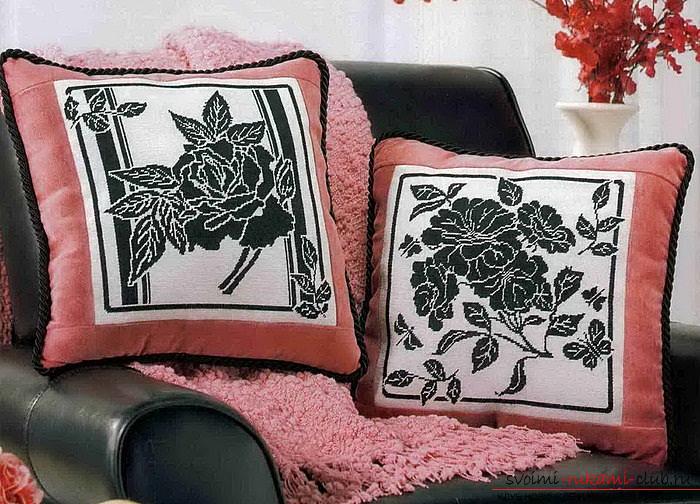 Types of monochrome embroidery Under the concept of "monochrome"understand several variants of embroidery, among which we can name contour embroidery, blackwork (embroidery in black threads), monochrome smoothness or monochrome embroidery with a cross. Let's talk in more detail about each kind of such embroidery.
Types of monochrome embroidery Under the concept of "monochrome"understand several variants of embroidery, among which we can name contour embroidery, blackwork (embroidery in black threads), monochrome smoothness or monochrome embroidery with a cross. Let's talk in more detail about each kind of such embroidery.  Contour monochrome embroidery To createcloth, using the technology of contour embroidery, you need to use a countable cross. The finished product in this case will look like a sketch of a landscape painter. Embroider a contour of a figure or silhouette with the help of thin lines. Elements that should be emphasized are added with small strokes. Such products will have a slightly unfinished appearance, which makes it look a little mysterious, prompting the imagination to work.
Contour monochrome embroidery To createcloth, using the technology of contour embroidery, you need to use a countable cross. The finished product in this case will look like a sketch of a landscape painter. Embroider a contour of a figure or silhouette with the help of thin lines. Elements that should be emphasized are added with small strokes. Such products will have a slightly unfinished appearance, which makes it look a little mysterious, prompting the imagination to work.  Contour embroidery is rightfully considered the mostAn affordable version of monochrome, which is ideal for beginner novices. A simple design solution, often, is carried out with the help of one color. The scheme can be made independently, but you can use the finished one, offered in our master classes. Make embroidery more original, thanks to a small bright element in its structure. It can be, for example, a colorful flower, blue eyes or red lips.
Contour embroidery is rightfully considered the mostAn affordable version of monochrome, which is ideal for beginner novices. A simple design solution, often, is carried out with the help of one color. The scheme can be made independently, but you can use the finished one, offered in our master classes. Make embroidery more original, thanks to a small bright element in its structure. It can be, for example, a colorful flower, blue eyes or red lips. 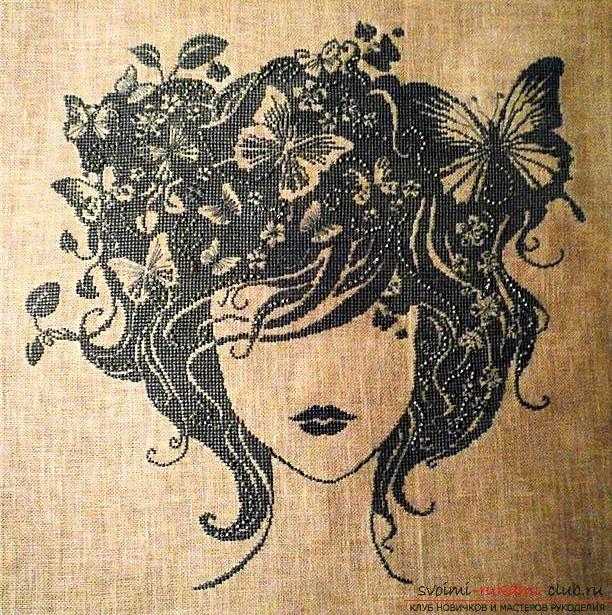 In contour embroidery, there are some nuances:
In contour embroidery, there are some nuances:
- For work it is necessary to choose high quality threads that are not polished;
- on the canvas it is necessary to mark out the threads, because the pencil can not be removed even after you have washed the product;
- The edges of the threads must be hidden only under the crosses that are embroidered, otherwise they will be visible from the opposite side;
- the tissue base must also be of high quality;
- choosing a frame for a finished product, one should take into account the fact that the contours will look better in a wide space.
 This kind of embroidery is most often used forcreation of paintings and souvenirs, which can be made very quickly. Black-and-white embroidery or blackwork Monochrome embroidery should be created using threads of black color, while working on a canvas of light shade. Or vice versa. This kind of embroidery was used to decorate tablecloths and towels. After all, the threads of black have long been considered the most durable and reliable. After the high-quality dyes entered our everyday life, black color could be replaced by any other. For example, Italians happily use gold, green and red shades.
This kind of embroidery is most often used forcreation of paintings and souvenirs, which can be made very quickly. Black-and-white embroidery or blackwork Monochrome embroidery should be created using threads of black color, while working on a canvas of light shade. Or vice versa. This kind of embroidery was used to decorate tablecloths and towels. After all, the threads of black have long been considered the most durable and reliable. After the high-quality dyes entered our everyday life, black color could be replaced by any other. For example, Italians happily use gold, green and red shades.  Working in this technology, most often use 2 options for the line:
Working in this technology, most often use 2 options for the line:
- seam called "back needle";
- double shovchik (stitch "Holbein").
The last of these stitches received its name on behalf of the artist G. Holbein, who often painted the royal family in clothes embroidered with black and white embroidery.  The seam is created in two approaches, using aline, the 2nd approach should cover the unfilled seats of the 1st stage. As a result, the front and the underside of the finished product will not differ. Cross-stitching in this technology will be used to create a color solution for the most voluminous areas in order to give them more depth.
The seam is created in two approaches, using aline, the 2nd approach should cover the unfilled seats of the 1st stage. As a result, the front and the underside of the finished product will not differ. Cross-stitching in this technology will be used to create a color solution for the most voluminous areas in order to give them more depth. 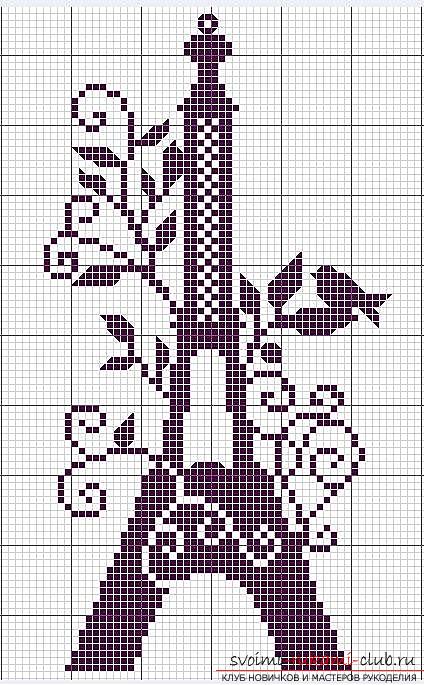 This technique is not easy to perform, so forThe creation of the product will require experience and perseverance. First you need to lay the outer edging of the product, and then inside it to make the appropriate pattern drawing, strictly observing the symmetry. In this case, the pattern will be a bit like lace. Be sure to monitor the tight tension of the thread, so that the stitches do not subsequently sag. Before work it is necessary to check all threads: for this, they should be soaked and rubbed with a shade of light shade. If as a result, any colored traces will be visible on the fabric, it is advised not to use these threads.
This technique is not easy to perform, so forThe creation of the product will require experience and perseverance. First you need to lay the outer edging of the product, and then inside it to make the appropriate pattern drawing, strictly observing the symmetry. In this case, the pattern will be a bit like lace. Be sure to monitor the tight tension of the thread, so that the stitches do not subsequently sag. Before work it is necessary to check all threads: for this, they should be soaked and rubbed with a shade of light shade. If as a result, any colored traces will be visible on the fabric, it is advised not to use these threads. 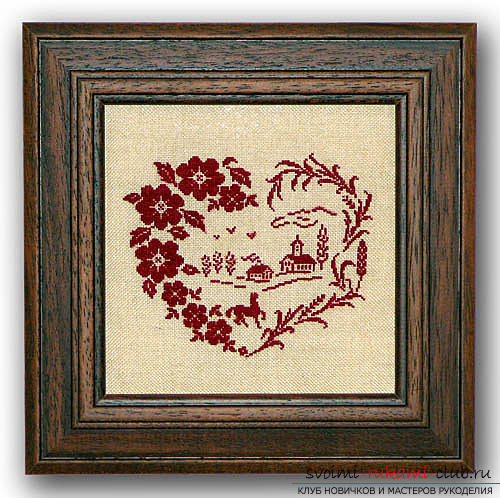 Monochrome embroidery by a cross In contrast to aboveconsidered variants of monochrome embroidery, this variety is completely executed by a cross. In this case, there are no unfilled cells. It should also be clarified that monochrome embroidery does not always provide for the presence of only one thread color. The most common is the option when the work includes several shades of the same color. So, for example, to achieve light tones, you need to mix the main color with white, and for dark tones it's important to add to the basic color of black. As a result, all the color components will perfectly harmonize with each other. Completed canvases made in the technique of monochrome cross-stitching, as a rule, resemble voluminous paintings by artists.
Monochrome embroidery by a cross In contrast to aboveconsidered variants of monochrome embroidery, this variety is completely executed by a cross. In this case, there are no unfilled cells. It should also be clarified that monochrome embroidery does not always provide for the presence of only one thread color. The most common is the option when the work includes several shades of the same color. So, for example, to achieve light tones, you need to mix the main color with white, and for dark tones it's important to add to the basic color of black. As a result, all the color components will perfectly harmonize with each other. Completed canvases made in the technique of monochrome cross-stitching, as a rule, resemble voluminous paintings by artists.  It is also worth noting that you can include in the workmelange threads. Due to what the need to choose the color solutions for the moulin will disappear, and the finished canvas will look very original and spectacular. But this kind of thread is better not to use when creating a portrait. To monochrome embroidery should also include 3-color and multi-color composition of shades. In 3-color work is carried out by 3 chromatic colors, and in multi-color - four or more.
It is also worth noting that you can include in the workmelange threads. Due to what the need to choose the color solutions for the moulin will disappear, and the finished canvas will look very original and spectacular. But this kind of thread is better not to use when creating a portrait. To monochrome embroidery should also include 3-color and multi-color composition of shades. In 3-color work is carried out by 3 chromatic colors, and in multi-color - four or more.  Which materials should be prepared formonochrome type of embroidery? A piece of cloth or canvas, in which there will be a necessary weave for you. When choosing the color of the canvas, one should be guided by the fact that the shades of the embroidery itself are not lost on it. On a light canvas, black and gray colors will look great. the tissue base itself can have a white or beige color. The most optimal is to use no more than 6 shades. Very impressive look paintings using brown. They have a kind of warmth and pleasantly act on the human eye. But the shades of gray are best used to create winter landscapes. For beginner needlewomen in the beginning, it is best to use the monochrome schemes of cross-stitching elements of kitchen or home orientation: a cup of tea or coffee, a pad for needles, postcards.
Which materials should be prepared formonochrome type of embroidery? A piece of cloth or canvas, in which there will be a necessary weave for you. When choosing the color of the canvas, one should be guided by the fact that the shades of the embroidery itself are not lost on it. On a light canvas, black and gray colors will look great. the tissue base itself can have a white or beige color. The most optimal is to use no more than 6 shades. Very impressive look paintings using brown. They have a kind of warmth and pleasantly act on the human eye. But the shades of gray are best used to create winter landscapes. For beginner needlewomen in the beginning, it is best to use the monochrome schemes of cross-stitching elements of kitchen or home orientation: a cup of tea or coffee, a pad for needles, postcards.


